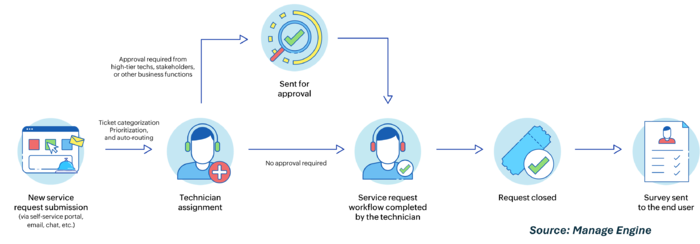Service Request
What is a Service Request?
A service request refers to a user's demand for information, advice, a standard change, or access to a service. Typically, it involves a request for something to be provided—for example, a request for software installation, password resets, or provision of information that is part of business-as-usual activities. In the context of IT service management (ITSM), these requests are managed through a service request management process, distinct from incident or problem management.
Role and Purpose of Service Requests
The primary role of service requests is to facilitate the delivery of standardized, low-risk services that are well-understood and documented. The purposes include:
- Providing Access to Services: Enabling users to easily request and receive standard services that they are entitled to within an organization.
- Ensuring Efficient Service Delivery: Streamlining the process of delivering routine services to enhance efficiency and user satisfaction.
- Maintaining Service Quality: Standardizing requests and their fulfillment processes to maintain consistency and quality of service.
Usage of Service Requests
Service requests are used in various operational contexts within an organization, such as:
- IT Services: These are common in IT departments for handling software access, hardware provisioning, or account modification requests.
- Human Resources: For requests related to employee services such as issuing employment letters, scheduling training sessions, or updating personal information.
- Facilities Management: Managing requests for office space relocations, equipment repairs, or booking of facilities.
Importance of Service Requests
Service requests are crucial because they:
- Support Operational Continuity: Provide a predictable and repeatable method of service delivery that supports the ongoing operations of an organization.
- Enhance User Satisfaction: By promptly and efficiently handling routine requests, they improve the overall experience of the users within an organization.
- Optimize Resource Utilization: Streamline and standardize how resources are allocated for routine tasks, allowing for better planning and utilization of resources.
Benefits of Service Requests
Implementing an effective service request management process offers several advantages:
- Improved Efficiency: Automating and standardizing service requests reduces manual handling and speeds up resolution times.
- Increased Transparency: Tracking and managing service requests through a dedicated system improves visibility for both service providers and users.
- Enhanced Control: Standard procedures for handling service requests ensure that all actions are per organizational policies and guidelines.
Examples of Service Requests in Practice
- Software Installation Requests: An employee requests the installation of licensed software necessary for their tasks.
- Access Requests: A new employee needs credentials and access rights to various internal systems.
- Facilities Requests: Booking a conference room equipped with specific audio-visual equipment for a scheduled meeting.
Service requests are a fundamental aspect of service management in any organization, enabling structured and efficient handling of routine requests that support the day-to-day operations and services. Properly managing these requests ensures that users receive timely and effective solutions, contributing to overall productivity and satisfaction.
See Also
- IT Service Management (ITSM): Discussing the broader field of ITSM, within which service requests are managed as part of service operations to ensure timely and effective handling of user needs.
- Incident Management: Differentiating service requests from incidents, where incident management focuses on restoring normal service operation as quickly as possible after an interruption.
- Change Management: Explaining how service requests for standard changes (pre-approved, low-risk changes) are handled within the change management process.
- Help Desk: Discussing the role of help desks and support services in processing and fulfilling service requests, ensuring customer satisfaction and operational efficiency.
- Customer Relationship Management (CRM): Linking to how service requests are managed within CRM systems to enhance customer interactions and service delivery.
- Service Level Agreement (SLA): Explaining the importance of SLAs in defining the expectations and responsibilities related to service requests, including timeliness and quality of response.
- Service Catalog: Covering the service catalog, which lists all available IT services, and how it is used to standardize service requests and streamline their fulfillment.
- User Experience Design (UX): Discussing how effectively managing service requests impacts user experience and satisfaction.
- Knowledge Management: Explaining the role of knowledge management in supporting service request processes by providing valuable resources and information to both users and service providers.

